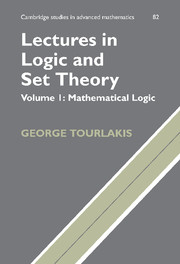Preface
Published online by Cambridge University Press: 16 January 2010
Summary
Both volumes in this series are about what mathematicians, especially logicians, call the “foundations” (of mathematics) – that is, the tools of the axiomatic method, an assessment of their effectiveness, and two major examples of application of these tools, namely, in the development of number theory and set theory.
There have been, in hindsight, two main reasons for writing this volume. One was the existence of notes I wrote for my lectures in mathematical logic and computability that had been accumulating over the span of several years and badly needed sorting out. The other was the need to write a small section on logic, “A Bit of Logic” as I originally called it, that would bootstrap my volume on set theory on which I had been labouring for a while. Well, one thing led to another, and a 30 or so page section that I initially wrote for the latter purpose grew to become a self-standing volume of some 300 pages. You see, this material on logic is a good story and, as with all good stories, one does get carried away wanting to tell more.
I decided to include what many people will consider, I should hope, as being the absolutely essential topics in proof, model, and recursion theory – “absolutely essential” in the context of courses taught near the upper end of undergraduate, and at the lower end of graduate curricula in mathematics, computer science, or philosophy. But no more. This is the substance of Chapter I; hence its title “Basic Logic”.
- Type
- Chapter
- Information
- Lectures in Logic and Set Theory , pp. ix - xiiPublisher: Cambridge University PressPrint publication year: 2003

